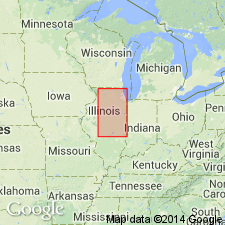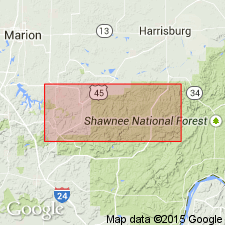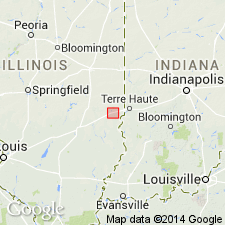
- Usage in publication:
-
- Cahokia Alluvium
- Modifications:
-
- Named
- Dominant lithology:
-
- Silt
- Clay
- Sand
- AAPG geologic province:
-
- Illinois basin
Summary:
Named for Cahokia, St. Clair Co., south-central IL. Consists of sand, silt, and clay of floodplain and alluvial deposits. Thickness about 14 m, ranges from 3 to 23 m. Locally underlies Grayslake Peat, Lacon Formation, Parkland Sand, or Peyton Formation. Age is Quaternary.
Source: GNU records (USGS DDS-6; Reston GNULEX).

- Usage in publication:
-
- Cahokia Formation
- Modifications:
-
- Overview
- AAPG geologic province:
-
- Illinois basin
Summary:
Surface deposit in almost all of the valleys of the study area. May overlie the Oak formation (new, informal), the Equality Formation, or the Teneriffe Silt. Thickness varies; ranges from 0 to 8.4 m. Generally texture is silt loam, but may consist of loamy sand, sandy loam, silty clay loam, silty clay, and loam. Contains a high percentage of kaolinite plus chlorite and illite. Texture indicates it originated from loess or redeposited loess. Arbitrary vertical line separates fluvial deposits of the Cahokia Formation from the colluvial deposits of the Peyton. Age is Holocene.
Source: GNU records (USGS DDS-6; Reston GNULEX).

- Usage in publication:
-
- Cahokia Alluvium
- Modifications:
-
- Biostratigraphic dating
- Age modified
- Overview
- AAPG geologic province:
-
- Illinois basin
Summary:
In the study area, the Cahokia occurs below wide terraces along valleys 1 to 10 ft above the modern stream beds, and in the channels of modern rivers and streams. Unit is divided into a lower sand and gravel facies and an upper silt loam facies. The sand and gravel facies, composed of uniform to stratified, coarse grained sediment, is as much as 34 ft thick. The silt loam facies, composed of pedogenically altered soft, leached, uniform to vaguely laminated silt loam is 14.6 ft thick in the North Fork Embarras River valley. The silt loam facies probably originated as overbank sediment and as tongues of colluvium. Four radiocarbon ages spanning 23,700 to 320 yr B.P. were determined from wood fragments and organic debris adjacent to the Martinsville site Two ages from sediment in the valley of the North Fork Embarras are Holocene, including an age of 8,370 +/-300 yr B.P. from small woody fragments and powdery organic-rich debris. A fragment of hickory wood in alluvium yielded an age of 320 +/-70 yr B.P. Two ages from Bluegrass Creek are late Wisconsinan. A coniferous wood fragment yielded an age of 23,720 +/-300 yr B.P., while another yielded an age of 14,490 +/-140 yr B.P. Portions of the unit may be as old as late Illinoian.
Source: GNU records (USGS DDS-6; Reston GNULEX).
For more information, please contact Nancy Stamm, Geologic Names Committee Secretary.
Asterisk (*) indicates published by U.S. Geological Survey authors.
"No current usage" (†) implies that a name has been abandoned or has fallen into disuse. Former usage and, if known, replacement name given in parentheses ( ).
Slash (/) indicates name conflicts with nomenclatural guidelines (CSN, 1933; ACSN, 1961, 1970; NACSN, 1983, 2005, 2021). May be explained within brackets ([ ]).

